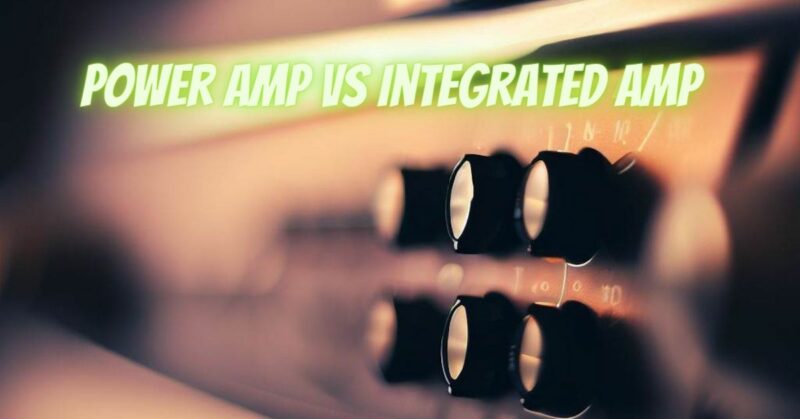When building a sound system, one common dilemma is choosing between a power amplifier (power amp) and an integrated amplifier (integrated amp). Both options have their merits and cater to different needs. In this article, we’ll explore the differences between power amps and integrated amps, helping you determine the best choice for your audio setup.
- Power Amplifier (Power Amp): A power amplifier is a dedicated component designed solely to amplify an audio signal and provide power to speakers. It serves as the final amplification stage in a system and requires a separate preamplifier or control unit to adjust volume, select sources, and control audio inputs. Power amps are typically built with high-quality amplification circuits and robust power supplies, focusing on delivering clean and efficient amplification to speakers.
- Integrated Amplifier (Integrated Amp): An integrated amplifier combines both the preamplifier and power amplifier functions into a single unit. It integrates the amplification and control stages, offering convenience and a simplified setup. Integrated amps typically include volume control, input selection, tone controls, and other features within a single chassis. They are designed to be a one-box solution, combining both amplification and control functionalities.
Differences between Power Amps and Integrated Amps:
a) Flexibility and Expandability: Power amps provide flexibility in system configuration since they require a separate preamplifier or control unit. This allows for easy upgrades or changes to the preamplification stage without affecting the power amplification section. Integrated amps, on the other hand, offer a convenient all-in-one solution but may have limited expansion options.
b) Customization and Upgradability: Power amps allow for customization and optimization of the preamplification stage by selecting a separate preamp that suits your preferences and requirements. This flexibility enables fine-tuning and upgrades to the signal processing components. Integrated amps, while more compact and streamlined, may have limitations in terms of customizability and upgradability.
c) Sound Quality and Performance: Both power amps and integrated amps can deliver excellent sound quality, with performance dependent on the specific model and implementation. High-quality power amps and integrated amps can provide similar levels of audio fidelity and power output. However, some audiophiles argue that separating the amplification and control stages in power amps can potentially lead to better audio performance by reducing interference and signal degradation.
d) Cost and Space Considerations: Integrated amps often offer a more cost-effective and space-efficient solution since they combine multiple components into one unit. They are suitable for smaller setups or situations where simplicity and space-saving are prioritized. Power amps, on the other hand, require additional components, which can increase the overall cost and require more physical space.
Choosing the Best Option: The choice between a power amp and an integrated amp depends on your specific needs, preferences, and system requirements. Consider the following factors:
- System Configuration: Evaluate your system requirements and the level of customization or expandability you desire.
- Sound Preference: Determine if you prioritize potential sonic benefits from separating amplification and control stages.
- Cost and Space: Assess your budget, available space, and the overall simplicity or complexity you prefer in your audio setup.
Conclusion:
There is no definitive answer to whether a power amp or an integrated amp is the best option. Both have their advantages and cater to different preferences and requirements. Power amps provide flexibility and potential for customization, while integrated amps offer convenience and space-saving benefits. Consider your system configuration, sound preference, budget, and space limitations when making your decision. Ultimately, choose the option that aligns with your specific needs and delivers the best audio performance for your listening enjoyment.


